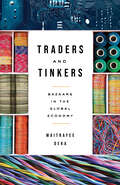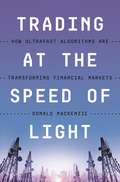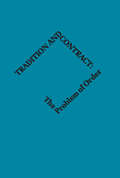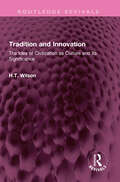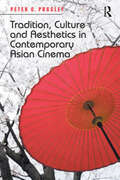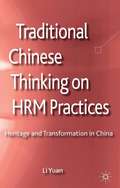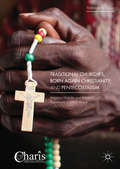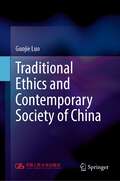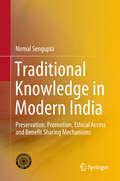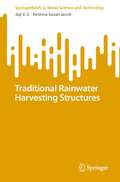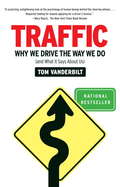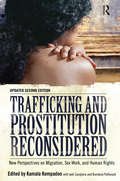- Table View
- List View
Traders and Tinkers: Bazaars in the Global Economy (Culture and Economic Life)
by Maitrayee DekaThe term "tinker" calls to mind nomadic medieval vendors who operate on the fringe of formal society. Excluded from elite circles and characterized by an ability to leverage minimal resources, these tradesmen live and die by their ability to adapt their stores to the popular tastes of the day. In Delhi in the 21st century, an extensive network of informal marketplaces, or bazaars, has evolved over the course of the city's history, across colonial and postcolonial regimes. Their resilience as an economic system is the subject of this book. Today, instead of mending and selling fabrics and pots, these street vendors are primarily associated with electronic products—computers, cell phones, motherboards, and video games. This book offers a deep ethnography of three Delhi bazaars, and a cast of tinkers, traders, magicians, street performers, and hackers who work there. It is an exploration, and recognition, of the role of bazaars and tinkers in the modern global economy, driving globalization from below. In Delhi, and across the world, these street markets work to create a new information society, as the global popular classes aspire to elite consumer goods they cannot afford except in counterfeit.
Trading Caterpillar Fungus in Tibet: When Economic Boom Hits Rural Area (Global Asia)
by Emilia Roza SulekWhen the demand for, and prices of caterpillar fungus (Ophiocordyceps sinensis, 'the Himalayan Viagra', long a part of traditional Chinese medicine) soared, the pastoralists of Golok on the Tibetan plateau where the fungus is endemic dug up, dried and sold the fungus to traders. In the process, these yak and sheep farmers, used to living on the edge of subsistence, became wealthy beyond their imagination. Trading Caterpillar Fungus in Tibet: When Economic Boom Hits Rural Area tells the story of what they do with the money they earned from gathering and trading caterpillar fungus, and what this money does to them, revealing a sophistication few outsiders would credit them for.
Trading Life: Organ Trafficking, Illicit Networks, and Exploitation
by Seán ColumbThis groundbreaking book investigates the emergence and evolution of the organ trade across North Africa and Europe. Seán Columb illuminates the voices and perspectives of organ sellers and brokers to demonstrate how crime and immigration controls produce circumstances where the business of selling organs has become a feature of economic survival. Drawing on the experiences of African migrants, Trading Life brings together five years of fieldwork charting the development of the organ trade from an informal economic activity into a structured criminal network operating within and between Egypt, Libya, Sudan, Eritrea, and Europe. Ground-level analysis provides new insight into the operation of organ trading networks and the impact of current legal and policy measures in response to the organ trade. Columb reveals how investing financial and administrative resources into law enforcement and border securitization at the expense of social services has led to the convergence of illicit smuggling and organ trading networks and the development of organized crime. Trading Life delivers a powerful and grounded analysis of how economic pressures and the demands of survival force people into exploitative arrangements, like selling a kidney, that they would otherwise avoid. This fascinating and accessible book is a must-read for anyone interested in migration, organized crime, and exploitation.
Trading Up: The New American Luxury
by Michael Silverstein Neil FiskeA fascinating look at why millions of consumers are "trading up" to premium goods, and how companies can profit from this phenomenon. Middle-market consumers have more discretionary income than ever before and are willing to pay extra for "new luxury" goods and services-items that deliver higher quality, technical advantages, and superior performance to conventional products. Above all, consumers are looking for emotional engagement-they look to products to help them manage the stresses of everyday life, and to help them realize their aspirations. A new luxury good may be as simple as a shampoo ($9 from Aveda, versus $3 from Suave) that brings moments of comfort and sensual pleasure, or as complex as a car ($26,000 for a bottom-of-the-line Mercedes, versus $20,000 for a Pontiac) that delivers feelings of safety and excitement. Clothing, cars, beer, coffee, kitchen appliances, lingerie, personal care, pet food, restaurants-in dozens of categories, new luxury goods occupy a sweet spot in the market, because they can sell in much higher unit volumes than "old luxury" goods, but command much higher profit margins than ordinary products. But new luxury leaders-such as Callaway Golf, Victoria's Secret, Panera Bread, Belvedere vodka, Whirlpool Duet, and Williams-Sonoma-create andmarket their goods very differently than do conventional companies. Trading Upexplores what's driving this move to premium goods, tells the inside stories of many New Luxury companies and their leaders, and offers insights and methods that can help the reader take advantage of this remarkable phenomenon. The book is based on the authors' experience in helping clients create billions of dollars worth of New Luxury products as well as on exhaustive supporting research.
Trading at the Speed of Light: How Ultrafast Algorithms Are Transforming Financial Markets
by Donald MacKenzieA remarkable look at how the growth, technology, and politics of high-frequency trading have altered global financial marketsIn today’s financial markets, trading floors on which brokers buy and sell shares face-to-face have increasingly been replaced by lightning-fast electronic systems that use algorithms to execute astounding volumes of transactions. Trading at the Speed of Light tells the story of this epic transformation. Donald MacKenzie shows how in the 1990s, in what were then the disreputable margins of the US financial system, a new approach to trading—automated high-frequency trading or HFT—began and then spread throughout the world. HFT has brought new efficiency to global trading, but has also created an unrelenting race for speed, leading to a systematic, subterranean battle among HFT algorithms.In HFT, time is measured in nanoseconds (billionths of a second), and in a nanosecond the fastest possible signal—light in a vacuum—can travel only thirty centimeters, or roughly a foot. That makes HFT exquisitely sensitive to the length and transmission capacity of the cables connecting computer servers to the exchanges’ systems and to the location of the microwave towers that carry signals between computer datacenters. Drawing from more than 300 interviews with high-frequency traders, the people who supply them with technological and communication capabilities, exchange staff, regulators, and many others, MacKenzie reveals the extraordinary efforts expended to speed up every aspect of trading. He looks at how in some markets big banks have fought off the challenge from HFT firms, and how exchanges sometimes engineer technical systems to favor certain types of algorithms over others.Focusing on the material, political, and economic characteristics of high-frequency trading, Trading at the Speed of Light offers a unique glimpse into its influence on global finance and where it could lead us in the future.
Tradition and Contract: The Problem of Social Order
by A. James GregorFirst Published in 2017. Routledge is an imprint of Taylor & Francis, an Informa company.
Tradition and Innovation: The Idea of Civilization as Culture and Its Significance (Routledge Revivals)
by H.T. WilsonFirst published in 1984 Tradition and Innovation by viewing Western civilization as a culture, puts the common perspectives of our major Western institutions in bolder relief. The author shows how the institutionalization of central modes of Western rationality-found in capitalism, industrialization, science, science - based technology, bureaucracy, the rule of law, the social and behavioral sciences-has created a culturally and historically unique form of collective life: advanced industrial society. Indicative of this development is the nature and meaning of the so-called innovative society itself, where rationality is increasingly seen to repose in institutions and organized structures rather than in individuals. Professor Wilson argues that this rationality is becoming traditionalized as a central artifact of our form of life, one which believes in the independent existence of the ‘facts of life’. This is borne out by the increasing autonomy of what professor Wilson calls ‘disembodied disciplined observation’, determined as it is to annihilate contemplation and reflection in its effort to reconstitute practice in its own image. This is an interesting read for students of sociology, political science, public administration, and social science in general.
Tradition and Policy Perspectives in Kinship Care
by Rowena Grice Wilson Sandra Edmonds CreweKinship care is part tradition and part social welfare policy. Tradition and Policy Perspectives in Kinship Care examines the balance of the two perspectives and presents current practice challenges of formal and informal kinship care. This important resource focuses on both the needs of the caregiver as well as the impact of kinship care on children. Public policy issues related to kinship care are discussed in detail. This insightful book explores this crucial issue through the lens of social workers who fully understand the strengths and challenges of kinship care.Tradition and Policy Perspectives in Kinship Care discusses this issue from both micro and macro levels, explaining the outcomes of kinship based on variables such as the youth’s and parent’s outlook for the future, performance in school, welfare reform, domestic violence, respite care, spirituality, and involvement of nonbiological relatives. The book then focuses on the subject of grandparents as caregivers, examining their coping resources, effectiveness of programs serving them, and recommended changes to services to enhance their well-being. Topics in Tradition and Policy Perspectives in Kinship Care include: study examining the future outlook in African American kinship care families the effect of family disruption on a child’s educational performance the impact of the Temporary Assistance to Need Families (TANF) legislation and future policy links between domestic violence and kinship care the role of spirituality and religion in kinship care a study on the needs of biological parents the impact of a grandparent’s parenting responsibilities on his or her psychological well-being intergenerational communication kinship care in public housing examination of the factors that influence kinship care provided by African American grandfathers AARP study of grandparents raising grandchildren in the District of Columbia the KinNET project funded by the Children’s Bureau for a national support network for kinship care providersTradition and Policy Perspectives in Kinship Care is an invaluable resource for social workers, counselors, child welfare agency administrators and practitioners, educators, and graduate students.
Tradition and Revolt
by Robert A. NisbetThis classic volume deals with a crucial contemporary social issue: the conflict between traditionalism and modernism. Nisbet considers such subjects as power, community, culture, and the university. He deals directly with the values of authority, tradition, hierarchy, and community on the one hand, and individualism, secularism, and revolt on the other. Nisbet's underlying argument is that there is a close historical relationship between the distribution of power in democratic society and the displacement of social class, kinship, neighborhood, and the church. The book challenges concerned Americans to understand and address the basic conflicts confronting contemporary society.In his introduction, Robert G. Perrin shows how the chapters in this volume reflect Nisbet's sociological vision exemplified throughout his career. Perrin notes that when these writings first appeared, they stimulated and informed debate on a broad range of topics such as value conflict, leadership, community, sociology, social class, technology, and the university. They also foreshadowed works yet to come in Nisbet's long and distinguished intellectual journey.Originally published in 1968, Tradition and Revolt was greeted with thoughtful reviews in leading sociology journals. Writing in the American Journal of Sociology, Joseph R. Gusfield called it "so welcome a publication," one containing "remarkable contributions to the analysis of modern society." Nisbet's vision of Western social life as shaped by the struggle between the dialectically opposed values of tradition and modernity illuminates contemporary issues. Tradition and Revolt will be of particular value to sociologists, cultural historians, and political theorists.Robert A. Nisbet (1913-1996) was Albert Schweitzer Professor Emeritus of the Humanities at Columbia University, and before that, dean of the School of Humanities at the University of California at Riverside. Among his many books are History of the Idea of Progress, The Sociological Tradition, The Degradation of the Academic Dogma, and Teachers and Scholars, all available from Transaction.Robert G. Perrin is professor of sociology and director of graduate studies at the University of Tennessee.
Tradition, Culture and Aesthetics in Contemporary Asian Cinema
by Peter C. PugsleyFrom the critically acclaimed Malaysian film Sepet to the on-going box office successes of the films created by Hong Kong director Wong Kar Wai, cinematic texts from the nations of Asia are increasingly capturing audiences beyond their national boundaries. Tradition, Culture and Aesthetics in Contemporary Asian Cinema explores the rise of popular Asian cinema and provides an understanding of the aesthetic elements that mark these films as 'Asian cinema'. Incorporating examples of contemporary films from China, Japan, Hong Kong, Korea, Singapore, Malaysia and India, Peter C. Pugsley gives readers a fresh insight into the rapidly developing discourse on popular Asian media. The book's chapters focus on the aesthetic features of national cinemas and the intersections of local/global encountered in the production, distribution and consumption of contemporary Asian films. By tracking across some of the most influential countries in Asia the book is able to offer new perspectives into the visual and aural features that create greater understanding between East and West. As distribution and technological advances make Asian films more readily available, an understanding of the different aesthetics at play will enable readers of this book to recognise key cultural motifs found in cinematic texts from Asia.
Tradition-Based Natural Resource Management: Practice and Application in the Hawaiian Islands (Palgrave Studies in Natural Resource Management)
by Edward W. GlazierThis book addresses the complex socio-political context of natural resource management in coastal and marine environments throughout the contemporary Pacific Islands and provides lessons that can be applied around the globe. The author spotlights one particular case in which Native Hawaiians worked successfully to develop a formal policy mechanism through which to advise government agencies in the State of Hawaii on matters regarding traditional and customary use and management of the island’s natural resources. Glazier describes historic-traditional aspects of natural resource use and management in the Hawaiian Islands and the challenging process that was employed to enhance the capacity of modern Hawaiians to influence the course of their future. This process successfully broached and addressed truly difficult challenges, including but not limited to: the convening of representatives of a complex society of indigenous persons in order to elicit traditional place-based knowledge and varying perspectives on the appropriate use and management of natural resources; the incorporation of such knowledge and perspectives into the modern natural resource management and policy context; and the need to balance the interests of indigenous persons and those of more recently-arriving persons around the island chain. The lessons learned were many and varied and are particularly germane for resource managers, scientists, policymakers, and indigenous persons seeking to undertake balanced natural resource policy decisions in island, coastal, and indigenous settings around the Pacific and beyond.
Traditional Chinese Medicines: Molecular Structures, Natural Sources and Applications
by J Zhou G Xie X Yan G W A MilneThis title was first published in 2003. In laboratories around the world the active principles in traditional herbal medicines are being isolated and characterized. A systematic effort at the Chinese Academy of Sciences is underway to identify the structure-activity relationships that result from the link between chemistry and medicine that is permitted by this data. This book, which provides the only systematic English-language description of the chemical structures and pharmacological effects of compounds active in traditional Chinese medicines (TCMs), is now in its second edition. The new edition provides English-language monographs on over 9000 chemicals isolated from nearly 4000 natural sources used in Chinese medicine and features the addition of in-depth bioactivity data for many of the compounds. Effects and indications of the medicines are included. Extensive indexing permits cross-referencing among English, Chinese and Latin names for natural medicinal sources, effects and indications, and the chemical components of the medicines. The second edition of Traditional Chinese Medicines includes 2300 new compounds, 2400 additional plant sources, more CAS Registry Numbers, and more pharmacological data. The structure of the book has been extensively reorganised to make cross referencing the data much simpler. This new edition is therefore a substantial improvement on the first edition of this important reference on the structural chemistry of traditional Chinese medicines.
Traditional Chinese Thinking On Hrm Practices
by Li YuanSuggests important ramifications for both Western and Eastern Human Resources Practices and is the first research of its kind to empirically investigate the effect of Chinese core values, which originated from Chinese traditional thinking, on HRM practices in China.
Traditional Churches, Born Again Christianity, and Pentecostalism: Religious Mobility and Religious Repertoires in Urban Kenya (Christianity and Renewal - Interdisciplinary Studies)
by Yonatan N. GezIn Kenya's vibrant urban religious landscape, where Pentecostal and traditional churches of various orientations live side by side, religious identity tends to overflow a single institutional affiliation. While Kenya’s Christianity may offer modes of coping with the fragilities of urban life, it is subject to repeated crises and schisms, often fueled by rumors and accusations of hypocrisy. In order to understand the unfolding of Kenyans’ dynamic religious identities, and inspired by the omnipresent distinction between ‘religious membership’ and ‘church visits,’ Yonatan N. Gez considers the complementary relations between a center of religious affiliation and expansion towards secondary practices. Building on this basic distinction, the book develops a theoretical innovation in the form of the ‘religious repertoire’ model, which maps individuals’ religious identities in terms of three intertwined degrees of practice.
Traditional Ethics and Contemporary Society of China
by Guojie LuoBased on the ethical thinking of the pre-Qin Dynasty, this book discusses the formation and development of traditional Chinese ethics, the refinement of the Confucian ethical normative system and the establishment of its orthodoxy, as well as the deepening and maturation of feudal ethics. The book is simple in style and clear in context. It contains not only the essence of traditional Chinese morality but also the achievements of modern civilization. It analyzes the implications of traditional Chinese ethics on the governance and moral construction of modern society and can be used as a reference for governance and revitalization of the country and moral development.
Traditional Knowledge in Modern India: Preservation, Promotion, Ethical Access and Benefit Sharing Mechanisms
by Nirmal SenguptaThis book demonstrates how traditional knowledge can be connected to the modern world. Human knowledge of housing, health and agriculture dates back thousands of years, with old wisdom developing and becoming modern. But in the past few decades, global communities have increasingly become aware that some of this valuable knowledge has fallen by the wayside. This has sparked systematic efforts at the local, national and global levels to connect this neglected knowledge to the modern world.It discusses the origin of the topic, its importance, recent developments in India and abroad, and what is being done and still needs to be done in order to preserve India’s traditional knowledge. The discussions address a broad range of fields and organizations: from Basmati rice to Ayurvedic cosmetics; from traditional irrigation and folk music to modern drug discovery and climate change adaptation; and from the Biodiversity Convention to the WHO, WTO and WIPO.
Traditional Rainwater Harvesting Structures (SpringerBriefs in Water Science and Technology)
by Joji V.S. Reshma Susan JacobThis book contains detailed information about the traditional rainwater structures. Harvesting rainwater is becoming as a practical adaptation strategy for urban areas that are vulnerable to climate alteration. In the past, rainwater harvesting was more significant than it is today. Studies show that a variety of traditional and age-old rainwater gathering techniques were created or put into use in reaction to earlier climate change incidents. According to history, both floods and droughts were frequent occurrences in ancient India. Perhaps this explains why each region of the nation has its own traditional water gathering practices that are representative of the local physical and cultural diversity. All of these methods can be seen as a concept of harvesting rain whenever and wherever it falls. Water makes up 70.9 % of the Earth's surface, mainly in the form of oceans and seas. Water is found in modest proportions as 1.7 % groundwater, 1.7 % glaciers and ice caps in Antarctica and Greenland, vapour, clouds (ice and liquid water suspended in air), and 0.001% precipitation in the air. Evaporation, transpiration, evapo-transpiration, condensation, precipitation, root absorption, percolation, infiltration, base flow and runoff are processes that water goes through on its way to the sea.
Traditional Religion and Culture in a New Era
by Reimon BachikaWhere will postmodern culture lead us in the twenty-first century? Will it destroy traditional cultures together with the old, established religions that were its foundation? These questions and the new concerns they evoke are explored in this important collection of original essays. Contributors challenge entrenched assumptions about what many social scientists consider irreversible cultural trends. These include cultural differentiation, emphasis on individual identity, movement toward religion as a private act rather than a community commitment, and above all, emphasis on the relativity of all knowledge and values.The volume asserts three lines of argument in opposition to these trends. The first is the teleological significance of traditional religions and archaic knowledge. History can be said to have no goal, but the same must not follow for human culture. One can conceive individually of a hundred goals to live for. However, the quality of life cannot be that diverse. Taken to the extreme, cultural particularity and philosophical nihilism are insults to the life that emerged on our planet eons ago. Second, this volume emphasizes moral concern and the importance of universal values. Ideas of human well being have been formulated from ancient times. Religious beliefs invariably contain statements of value in the form of commandments and exhortations that express fundamental goals for a quality of life. Third, the nature of religion and spirituality is discussed. Religion today has become controversial socially, and marginal sociologically. The role of religion in society is sometimes problematic or abused, but it is also underestimated and misunderstood. The authors suggest that contemporary religion might best be viewed as non-ideological spiritual culture. This, in turn, looks to a future in which religion and culture coalesce.This volume includes an international cast of scholars from Japan, the United States, Canada, the United Kingdom, Germany, Greece, Italy, New Zealand, and Belgium. All have engaged in research outside their own countries. Taken as a whole, this volume addresses issues of interest to those in the fields of futures studies, religion, and philosophy, and in particular those concerned with human agency, personal responsibility, and public choice.
Traditionen juristisch-notarieller Textproduktion durch Translation: Zapotekisch-spanische Gerichtsakten in Neu-Spanien (Übersetzungskulturen der Frühen Neuzeit #6)
by Malte KneifelDieses Open Access-Buch bietet eine historisch ausgerichtete Untersuchung juristisch-notarieller Dokumente aus Neu-Spanien an der Schnittstelle zwischen romanistischer Textlinguistik und Translationswissenschaft. Konkret wird ein umfassendes Korpus aus Texten der indigenen Selbstverwaltung und Rechtsprechung analysiert, die in einer peripheren Region des kolonialen Mexiko zwischen dem 17. und 18. Jahrhundert in der indigenen Sprache Zapotekisch verfasst und zur Weitergabe an die spanisch-koloniale Gerichtsbarkeit ins Spanische übersetzt wurden. Grundlage der Analyse ist ein Modell, das textlinguistische und translationswissenschaftliche Ansätze integriert, darunter das Konzept der Diskurstraditionen und die Descriptive Translation Studies. Die Untersuchung liefert Erkenntnisse über die Entstehung und Entwicklung konkreter Traditionen der Produktion von Fachtexten innerhalb eines komplexen historischen Kontextes, für die Translation sowie deren Rezeption und Antizipation einen wesentlichen treibenden Faktor darstellen. Das Buch bietet damit nicht nur eine linguistische Aufarbeitung von aus dieser Perspektive bisher wenig bearbeiteten historischen, mehrsprachigen Dokumenten der spanischen Kolonialzeit, sondern trägt auch zu einer Integration von (romanistisch-)textlinguistischen und translationswissenschaftlichen Theorien für die Anwendung in konkreten historischen Forschungen bei. Es richtet sich somit an alle am Forschungsgegenstand Interessierten sowie an Textlinguist*innen und Translationswissenschaftler*innen, die ihr Forschungsfeld an ebendieser Schnittstelle verorten.
Traditions and Transformations of Habitation in Indonesia: Power, Architecture, and Urbanism
by Bagoes WiryomartonoThis book raises the issue of the practice of patrimonial power with a focus on habitations, particularly in the urban areas of Indonesia. An assemblage of interdisciplinary studies within the framework of environmental humanities, covering the arts, architecture, urban studies, geography, cultural anthropology, and sociology, this multifaceted framework divulges the interactive connectivity between Indonesia’s patrimonial culture and the socio-culturally constructed system of habitation. The interdisciplinary study of the pertinent practices of patrimonial power that have been represented and been manifested by various political and traditional regimes in terms of the built environment and habitation in Indonesia contributes to a new understanding of Indonesian urban spatial development, from the pre-colonial era to the present. The book poses that in order to understand the politics of Indonesia, one must understand the culture and tradition of the political leadership of the country. The author presents such an understanding in exploring and unpacking the relationship between people and place that constructs, develops, sustains, and conserves Indonesian culture and traditions of habitation. This book is of interest to graduate scholars and researchers in Asian Studies in numerous disciplines, including urban studies, urban planning and design, political science, architecture, anthropology of space, public administration, and political philosophy.
Traditn Econ Vill Ind Ils 74 (International Library of Sociology)
by K. IshwaranFirst published in 1998. Routledge is an imprint of Taylor & Francis, an informa company.
Traffic: Why We Drive The Way We Do (and What It Says About Us)
by Tom VanderbiltWould you be surprised that road rage can be good for society? Or that most crashes happen on sunny, dry days? That our minds can trick us into thinking the next lane is moving faster? Or that you can gauge a nation’s driving behavior by its levels of corruption? These are only a few of the remarkable dynamics that Tom Vanderbilt explores in this fascinating tour through the mysteries of the road. Based on exhaustive research and interviews with driving experts and traffic officials around the globe,Trafficgets under the hood of the everyday activity of driving to uncover the surprisingly complex web of physical, psychological, and technical factors that explain how traffic works, why we drive the way we do, and what our driving says about us. Vanderbilt examines the perceptual limits and cognitive underpinnings that make us worse drivers than we think we are. He demonstrates why plans to protect pedestrians from cars often lead to more accidents. He shows how roundabouts, which can feel dangerous and chaotic, actually make roads safer—and reduce traffic in the bargain. He uncovers who is more likely to honk at whom, and why. He explains why traffic jams form, outlines the unintended consequences of our quest for safety, and even identifies the most common mistake drivers make in parking lots. The car has long been a central part of American life; whether we see it as a symbol of freedom or a symptom of sprawl, we define ourselves by what and how we drive. As Vanderbilt shows, driving is a provocatively revealing prism for examining how our minds work and the ways in which we interact with one another. Ultimately,Trafficis about more than driving: it’s about human nature. This book will change the way we see ourselves and the world around us. And who knows? It may even make us better drivers.
Trafficked Children and Youth in the United States: Reimagining Survivors
by Elzbieta M. GozdziakTrafficked children are portrayed by the media--and even by child welfare specialists--as hapless victims who are forced to migrate from a poor country to the United States, where they serve as sex slaves. But as Elzbieta M. Gozdziak reveals in Trafficked Children in the United States, the picture is far more complex. Basing her observations on research with 140 children, most of them girls, from countries all over the globe, Gozdziak debunks many myths and uncovers the realities of the captivity, rescue, and rehabilitation of trafficked children. She shows, for instance, that none of the girls and boys portrayed in this book were kidnapped or physically forced to accompany their traffickers. In many instances, parents, or smugglers paid by family members, brought the girls to the U.S. Without exception, the girls and boys in this study believed they were coming to the States to find employment and in some cases educational opportunities. Following them from the time they were trafficked to their years as young adults, Gozdziak gives the children a voice so they can offer their own perspective on rebuilding their lives--getting jobs, learning English, developing friendships, and finding love. Gozdziak looks too at how the children's perspectives compare to the ideas of child welfare programs, noting that the children focus on survival techniques while the institutions focus, not helpfully, on vulnerability and pathology. Gozdziak concludes that the services provided by institutions are in effect a one-size-fits-all, trauma-based model, one that ignores the diversity of experience among trafficked children. Breaking new ground, Trafficked Children in the United States offers a fresh take on what matters most to these young people as they rebuild their lives in America.
Trafficking Trajectories: Vulnerability, Failed Systems, and the Case for Prevention (Pennsylvania Studies in Human Rights)
by Alicia W. PetersHighlights the role structural vulnerability plays in the lived realities of domestic sex trafficking survivors before, during, and after traffickingDrawing on survivor narratives and ethnographically rich accounts from frontline workers in New England, specifically Maine and New Hampshire, Trafficking Trajectories contextualizes the ways in which structural vulnerability is embodied by domestic sex trafficking survivors in complex ways over time. The book also makes legible where and when upstream responses are most needed to prevent trafficking from occurring.Trafficking Trajectories counters the dominant trafficking narrative of victims and villains and how this narrative decontextualizes and isolates the period of victimization and rescue from broader experiences of vulnerability. Instead, Alicia Peters centers survivor experience to highlight the role of structural violence and vulnerability before, during, and after trafficking. Focusing on the lived realities of survivors, she argues that prioritizing an interventionist criminal legal response to trafficking does little to address the issues that make individuals vulnerable to trafficking in the first place and fails to end trafficking.Peters combines nuanced accounts of survivors with the observations and quandaries faced by frontline workers to reveal opportunities for rethinking and broadening the response to trafficking to make it more focused on prevention, and thus more effective. The book reframes trafficking—not as sporadic instances of interpersonal violence requiring criminal legal intervention— but as structural violence that requires systematic and preventive intervention. Trafficking Trajectories concludes with a series of policy recommendations intended to address human trafficking at its root.
Trafficking and Prostitution Reconsidered: New Perspectives on Migration, Sex Work, and Human Rights
by Kamala Kempadoo Jyoti Sanghera Bandana PattanaikSince the 2005 publication of the highly acclaimed first edition of Trafficking and Prostitution Reconsidered, human trafficking has become virtually a household phrase. This new edition adds vitally important updates related to recent developments. A new introduction considers the term 'sex trafficking' and its growing use amongst feminist researchers. In a new chapter Ratna Kapur looks at changes in anti-trafficking legislation especially under the Obama administration. Jyoti Sanghera reports from her experience as a UN Human Rights commissioner and Bandana Pattanaik examines feminist participatory research on 'trafficking'. The book concludes with a list of relevant websites, organisations, and publications useful for students, researchers, and activists.
